The Plight of the Olive Ridley Turtle
Turtle Season 2012 Is Here
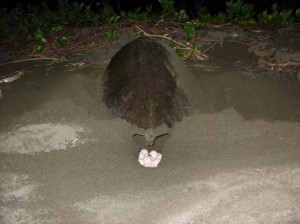
By Jack Ewing
Beliefs are often formed on the basis of a combination of myth and wishful thinking. Since the first pioneers began to settle the southern Pacific region of Costa Rica they have exploited the marine turtles, patrolling the beaches during turtle season, and digging up the freshly laid eggs. They have always done this not because their families are under nourished and need the eggs for their nutritional value, but rather because they believe the myth that turtle eggs will increase their sexual potency. This is ridiculous, of course, but it is, nevertheless, what motivates people to dig up the eggs and consume them. For this reason populations of marine turtles are diminishing.
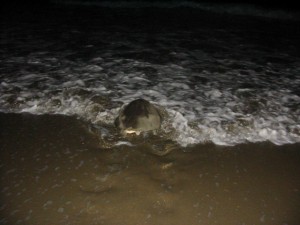
All species of marine turtles are protected by law, and digging up the eggs is prohibited as is selling them. The problem is that the penalties are so small that they are not a deterrent. A poacher is not likely to be caught and fined, and if he is, the fine is less than the value of one nest of turtle eggs. The eggs are usually sold to local bars and cantinas and bring about $0.40 US each, which means that an average nest with 100 eggs can be sold for about $40. The customers who buy the eggs drink them raw with a little tomato juice, lemon juice and tabasco sauce. It is the “manly” thing to do. I don’t see the logic of this. For example, I can’t imagine a big he-man standing up in a bar, saying, “Look at me. I’m a real man.” while poping a Viagra tablet into his mouth right there in front of everyone. Most men would be embarrassed for anyone to find out that they needed to take Viagra. So why do they think it is manly to eat turtle eggs, which are supposed to do the same thing. If any of you readers figure it out, let me know.
Since no amount of logic will convince people who have been consuming turtle eggs for years that they are not an aphrodisiac, and the law is not a deterrent, many concerned people have come up with a different solution. We try to get the eggs before the poachers do. We find them on the beach where the female turtle laid them, dig them up, and move them to a nursery. In the nursery we dig a hole the same diameter and depth as the hole where they were laid and bury the eggs just like they were on the beach. The eggs are white, about the size and shape of a golf ball, and soft. The shell is flexible and leathery.
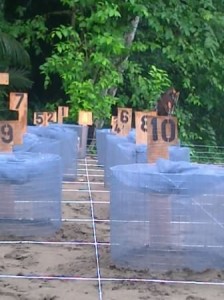
Incubation time will vary between 45 and 60 days depending on the temperature of the nest. Last year 90% hatched between 47 and 52 days after they were deposited in the sand. About 12 hours prior to emerging, a small depression appears over the nest. This is an indication that the first baby turtles are beginning to break through their shells. According to marine biologists they remain in the nesting chamber with the remains of the eggs shells until all have hatched. Then they dig their way to the surface. When they start emerging from the nest onto the sand it is important to take them to the beach within 30 minutes, or even sooner. The hatchlings have a yolk sac that contains all of the energy that they will have available to them until they get into the ocean and are able to find food. From the moment they emerge from the nest, onto the surface of the sand, they are in a constant state of movement, expending energy. If they don’t get to the sea quickly, they will use up the contents of the yolk sac and die.
Some people have suggested that we should carry the hatchlings into the water and even take them out past the breaking waves before releasing them, thereby eliminating a great deal of effort on their part and hopefully enhancing their survival rate. Nevertheless, marine biologists believe that walking across the beach and entering the water is essential to the well being of the young turtles. Apparently a small sample of sea water and sand enters a tiny organ near the nostril and remains there for the life of the turtle. An identical organ on the other side remains empty. According to the theory, ten to twelve years later, when the female turtles return to the beach to deposit their eggs, they are able to find the exact location of the beach where they entered the water by comparing samples of sea water with the sample taken when they first entered the ocean as hatchlings.
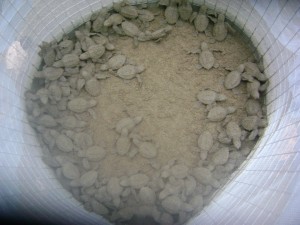
As soon as the first hatchlings emerge onto the sand, the park rangers call Hacienda Baru Lodge. We run around and notify all the guests we can find, that they have 30 minutes to get to the beach if they want to see the turtles enter the sea.
A very important part of the turtle project is environmental education in the local schools. The most effective way to teach a child to appreciate the marine turtles is to allow her/him to witness a release of baby turtles into the sea. This is combined with a video and a talk by one of the park rangers. More nests emerge in the early morning than any other time, so we coordinate the school visits for early morning on the days when there is a high probability of a hatching. Once a child has held a baby turtle in her/his hand, set it down on the beach, and watched it walk to the sea, enter the waves, and disappear, he or she will never eat a turtle egg. They will also urge their parents to desist from this destructive behavior. We have even had irate parents call and demand to know what kind of nonsense we are teaching their children. “Since the school class visited Hacienda Barú my daughter won’t even let me eat turtle eggs,” exclaimed one furious father. Hopefully there will be less poachers in the next generation.
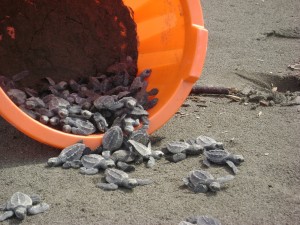
The first time we made a nursery was a spur-of-the-moment thing with absolutely no planning. The year was 1984, and there were so many poachers on the beach every night that they often ended up fighting over the eggs. Everyone carried a machete and the beach was a dangerous place to be. One weekend there was a community fiesta in the nearby town of Hatillo where most of the poachers lived. Everyone went to the fiesta and we, along with some other neighbors went to the beach to collect turtle eggs. We used some scrap lumber to make a sandbox where we buried the eggs. That weekend was on the waning quarter of the moon, and more turtles came to the beach to deposit their eggs than ever before. We collected a little over 4000 eggs for the nursery. We had heard about turtle nurseries, and knew more or less what to do. So we just did the best we could. Even with our inexperience we ended up releasing about 2500 baby turtles into the sea.
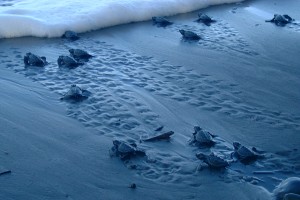
We continued the nursery as a project of the Hacienda Baru employees until 1990 when we began colaborating with an environmental group called ASANA. Over the years the project has evolved into a much more scientifically sound process. ASANA personnel and the Hacienda Barú park rangers have refined the handling and recording procedures used in the marine turtle rescue project. A marine biologist stops by once each month to offer advice and help solve problems. Over the last twelve years an average of 89 baby turtles have been successfully released into the sea for every 100 eggs acquired. This amounts to more than 90,000 hatchlings liberated since the year 2000. ASANA has also collaborated with other marine turtle rescue projects in this region.
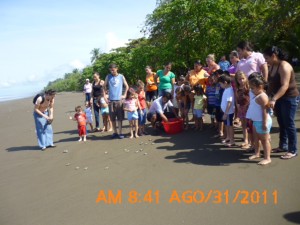
The Olive Ridley marine turtles begin laying eggs on Barú Beach in early July each year. August and September are the months when most of the eggs are laid. The laying continues at a slower rate through the month of October and dwindles down to nothing in November. Very few turtles come onto the beach during the week of the full moon, and seem to time their egg laying to the rest of the month. They have an uncanny sense that tells them what time of night the moon will rise and set, because they are seldom seen on the beach in the moonlight. Anyone who would like to accompany the park rangers on a turtle patrol are welcome to do so. You will have to walk several kilometers at night, often in the rain, and there is no guarantee that you will see a turtle. We ask for a voluntary donation of $15 per person for the people who partake of this activity. The donations help finance the project. If you are interested, please coordinate with our reception office 506 2787 0003. The receptionist will know if turtles have been seen in the last few nights.
Seeing baby turtles is a little easier to see than the adult females laying their eggs. The big hatching season is late September through early November when turtles hatch and are released almost every day.

